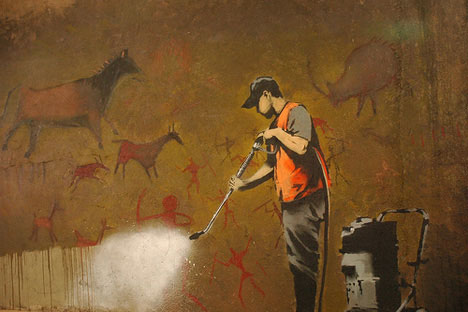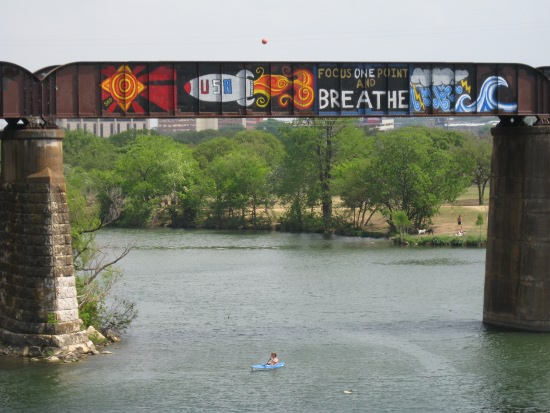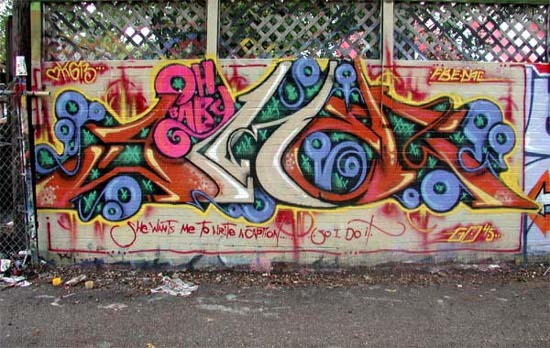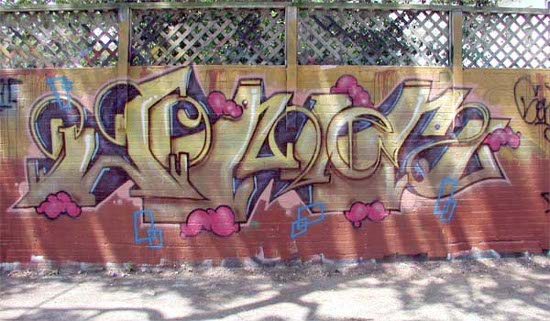
Graffiti by Banksy, Image via Holy Taco
As many of Banksy's works show, graffiti can convey social commentary. For example, the painting above, which shows a city worker sandblasting the famous Lascaux cave paintings just as he would modern day graffiti, wittily laments the blindness of local governments to public art.
The antagonism between government and graffiti artists is understandable; we cannot expect government officials to determine what is art and what is vandalism. At the same time, graffiti is public art to be encouraged, not suppressed. The longstanding criminality of the form makes it ideal for subsersive and counter-cultural messages. Even so, alongside simple, unappealing tags or wall-sized, astoundingly intricate paintings of pseudonyms, graffiti that bears an explicit message stands out. While Banksy's skillful works transmit these messages with a vigorous and unique style that accounts for much of his popularity, this type of work is seen elsewhere.
I discover such didactic art throughout Austin. The guiding philosophy rejects consumerism and conformity. I came across two particularly nice examples yesterday, while walking along the Pfluger pedestrian bridge over Town Lake:


"Breathe" is a call for mindfulness and focus within a series of images seemingly unconnected by anything other than style and color. "Robots" playfully suggests that we already act like robots without realizing it.
As Nate Kreuter notes in his post on graffiti, a key element is the audacity of the artist. Painting this train bridge surely counts as daring. A KXAN news report about the water rescue required for a tagger who jumped from it after being caught in broad daylight exemplifies the dangers. The reporter calls the artist a "graffiti vandal" and notes his bongos were also found; she thus makes it clear that this individual and, by extension, the art form in which he was engaged, is deviant and deserving of mockery.
But note the height of the bridge from which he jumped:

Why would someone take such a risk to create public art that many consider mere vandalism, art that the city will surely blast away within weeks if not days? The transitory nature of this form has led websites like Art Crimes to try and preserve via photographs the various pieces, including some in Austin. Here are two paintings by the same artist (Gomer) in the same place:


"Gomer" images via Art Crimes
The impermanence of the medium is, itself, part of the meaning. Not only must we reflect on the formal characteristics and the explicit or implicit messages, but also the effort put forth by an artist who knows the work will disappear. The result is an anonymous, altruistic art that momentarily beautifies and provokes before its inevitable destruction.
Comments
JR's Wish
I really enjoyed the post, Mike. I have been thinking about illegal art since I came across this work by JR, a semi-anonymous French artist, who started as a graffiti artist turned transformative public artist. He does these wonderful black-and-white portraits that intervene on places as a form of social justice, such as the "Women are Heroes" project. I am having my students participate in his public art project, but it's made me wonder what does it mean to encourage students to do graffiti? Should I have a caveat that we will be getting permissions to "install" our art works? That would fundamentally alter the nature of the project, woudln't it? I believe the idea of graffiti as an encouraged form of art completely transforms how we think about our role as educators, citizens, activitists, etc. On a side note, I have been thinking about the SXSW graffiti artist you mention here since I heard the news report. I keep wondering if he was okay in the end?
mm.. tres interesant!